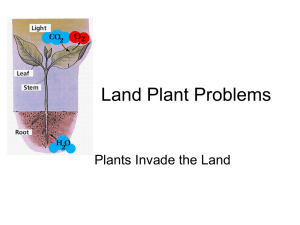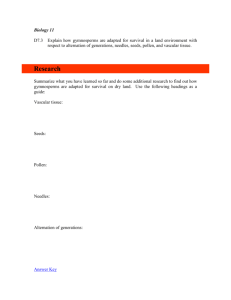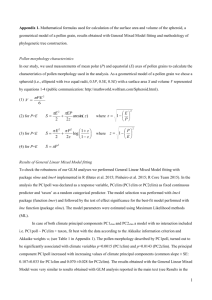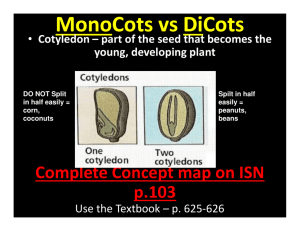Comparative Morphological, Anatomical, and Palynological Stachys L. sect. Ambleia Bentham
advertisement
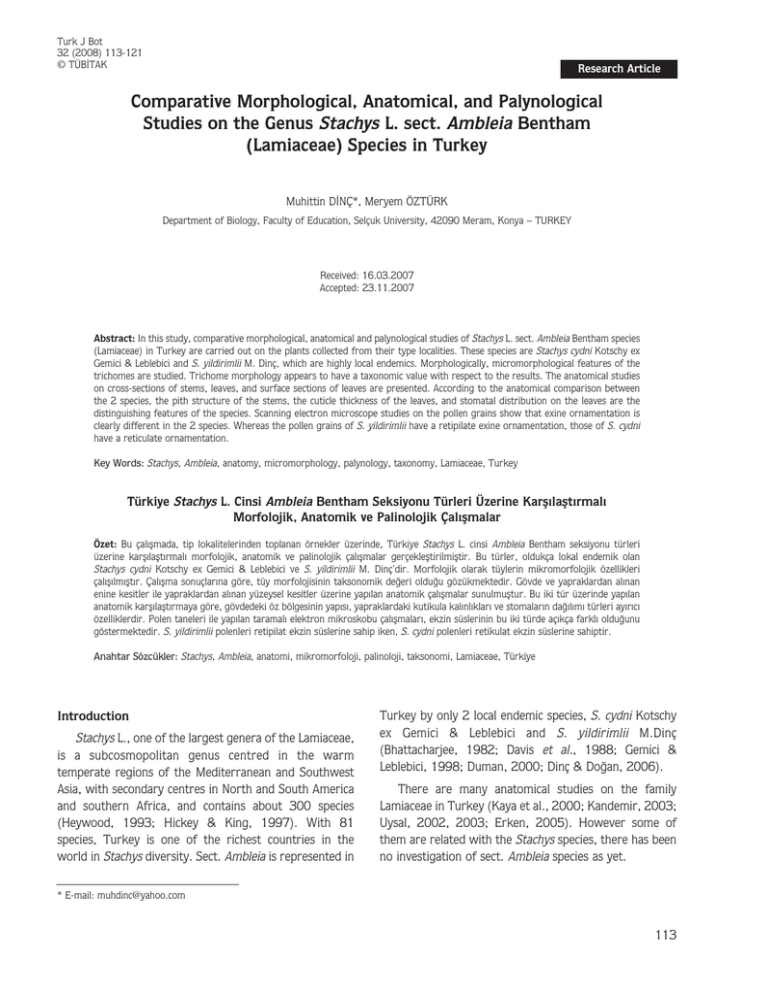
Turk J Bot 32 (2008) 113-121 © TÜB‹TAK Research Article Comparative Morphological, Anatomical, and Palynological Studies on the Genus Stachys L. sect. Ambleia Bentham (Lamiaceae) Species in Turkey Muhittin D‹NÇ*, Meryem ÖZTÜRK Department of Biology, Faculty of Education, Selçuk University, 42090 Meram, Konya – TURKEY Received: 16.03.2007 Accepted: 23.11.2007 Abstract: In this study, comparative morphological, anatomical and palynological studies of Stachys L. sect. Ambleia Bentham species (Lamiaceae) in Turkey are carried out on the plants collected from their type localities. These species are Stachys cydni Kotschy ex Gemici & Leblebici and S. yildirimlii M. Dinç, which are highly local endemics. Morphologically, micromorphological features of the trichomes are studied. Trichome morphology appears to have a taxonomic value with respect to the results. The anatomical studies on cross-sections of stems, leaves, and surface sections of leaves are presented. According to the anatomical comparison between the 2 species, the pith structure of the stems, the cuticle thickness of the leaves, and stomatal distribution on the leaves are the distinguishing features of the species. Scanning electron microscope studies on the pollen grains show that exine ornamentation is clearly different in the 2 species. Whereas the pollen grains of S. yildirimlii have a retipilate exine ornamentation, those of S. cydni have a reticulate ornamentation. Key Words: Stachys, Ambleia, anatomy, micromorphology, palynology, taxonomy, Lamiaceae, Turkey Türkiye Stachys L. Cinsi Ambleia Bentham Seksiyonu Türleri Üzerine Karfl›laflt›rmal› Morfolojik, Anatomik ve Palinolojik Çal›flmalar Özet: Bu çal›flmada, tip lokalitelerinden toplanan örnekler üzerinde, Türkiye Stachys L. cinsi Ambleia Bentham seksiyonu türleri üzerine karfl›laflt›rmal› morfolojik, anatomik ve palinolojik çal›flmalar gerçeklefltirilmifltir. Bu türler, oldukça lokal endemik olan Stachys cydni Kotschy ex Gemici & Leblebici ve S. yildirimlii M. Dinç’dir. Morfolojik olarak tüylerin mikromorfolojik özellikleri çal›fl›lm›flt›r. Çal›flma sonuçlar›na göre, tüy morfolojisinin taksonomik de¤eri oldu¤u gözükmektedir. Gövde ve yapraklardan al›nan enine kesitler ile yapraklardan al›nan yüzeysel kesitler üzerine yap›lan anatomik çal›flmalar sunulmufltur. Bu iki tür üzerinde yap›lan anatomik karfl›laflt›rmaya göre, gövdedeki öz bölgesinin yap›s›, yapraklardaki kutikula kal›nl›klar› ve stomalar›n da¤›l›m› türleri ay›r›c› özelliklerdir. Polen taneleri ile yap›lan taramal› elektron mikroskobu çal›flmalar›, ekzin süslerinin bu iki türde aç›kça farkl› oldu¤unu göstermektedir. S. yildirimlii polenleri retipilat ekzin süslerine sahip iken, S. cydni polenleri retikulat ekzin süslerine sahiptir. Anahtar Sözcükler: Stachys, Ambleia, anatomi, mikromorfoloji, palinoloji, taksonomi, Lamiaceae, Türkiye Introduction Stachys L., one of the largest genera of the Lamiaceae, is a subcosmopolitan genus centred in the warm temperate regions of the Mediterranean and Southwest Asia, with secondary centres in North and South America and southern Africa, and contains about 300 species (Heywood, 1993; Hickey & King, 1997). With 81 species, Turkey is one of the richest countries in the world in Stachys diversity. Sect. Ambleia is represented in Turkey by only 2 local endemic species, S. cydni Kotschy ex Gemici & Leblebici and S. yildirimlii M.Dinç (Bhattacharjee, 1982; Davis et al., 1988; Gemici & Leblebici, 1998; Duman, 2000; Dinç & Do¤an, 2006). There are many anatomical studies on the family Lamiaceae in Turkey (Kaya et al., 2000; Kandemir, 2003; Uysal, 2002, 2003; Erken, 2005). However some of them are related with the Stachys species, there has been no investigation of sect. Ambleia species as yet. * E-mail: muhdinc@yahoo.com 113 Comparative Morphological, Anatomical, and Palynological Studies on the Genus Stachys L. sect. Ambleia Bentham (Lamiaceae) Species in Turkey Investigations of pollen morphology in Lamiaceae have been essential as an aid to classification within this family (Abu-Assab & Cantino, 1994). However, the pollen morphology of the genus Stachys is not well known, and those of some Turkish Stachys taxa have been given by Moore et al. (1991) and Abu-Assab & Cantino (1994). Mersin: Çamlıyayla, Payam, Manastır area, limestone rocks, 1700 m, 12.VII.2004, M.Dinç 2188 & H.H. Do¤an (KNYA); C5 Mersin: Aslanköy; Cocakdere, Pinus nigra forest, clearings, rocky slopes, crevices of limestone rocks, 1700 m, 14.VII.2004, M. Dinç 2275 & H.H. Do¤an (KNYA). The taxonomic value of the indumentum and its importance in systematic and phylogenetic relationships are well known in Lamiaceae (Abu-Assab & Cantino, 1987). Trichomes are among the most useful taxonomic characters in some genera of the family. Their absence or presence and their typology can be used as taxonomic markers in the infrageneric classification of the genus Teucrium L., while the infrasectional classification of sect. Polium (Mill.) Schreb. is based almost totally on the typology of the trichomes (Navarro & El Oualidi, 2000). Trichome morphology is an essential taxonomic character for delimitation of the sections Ambleia Bentham and Zietenia (Gled.) Bentham in the genus Stachys as well. The section Ambleia is characterized by dendroid indumentum and it is isolated from other sections of Stachys by this feature (Bhattacharjee, 1980, 1982). These specimens were used for morphological and palynological studies. For the morphological studies, at least 20 individuals of each species were investigated. All measurements were determined on 30 trichomes for each species. Although general morphological features of the 2 species have been previously given (Gemici & Leblebici, 1998; Dinç & Do¤an, 2006), taxonomic value of trichome morphology for interspecific classification in the section Ambleia has been emphasized neither in these studies nor in the other studies on this section (Bhattacharjee, 1980, 1982; Rechinger, 1982). Here, we report on the comparison of the trichome morphologies of the 2 species. The aim of this paper is also to present the anatomical and palynological features of the 2 species and to discuss their taxonomic values. Materials and Methods Plant samples of the 2 species were collected from their type localities. The specimens are dried according to standard herbarium techniques and stored at KNYA and GAZI herbaria. The collecting localities of the species: S. yildirimlii. C5 Mersin: Aslanköy, Cocakdere, fiahinlik Tepe, rocky places, 1950 m, 12.VI.2005, M.Dinç 2336 & H.H. Do¤an (KNYA). S. cydni. C5 Mersin: Aslanköy, Cocakdere, fiahinkayası mevkii, Pinus nigra forest, clearings, rocky slopes, 1500 m, 08.VI.2003, M.Dinç 1794 & H.H. Do¤an (GAZI); C5 114 Some plant samples belonging to the 2 species (M.Dinç 2336 & H.H.Do¤an, M. Dinç 2275 & H.H. Do¤an) were fixed in 70% alcohol. Anatomical investigations were performed on the cross-sections of the herbaceous stems, woody stems and leaves, and the surface sections of leaves. The cross sections were painted with basic fuchsine and covered with glyceringelatin (Vardar, 1987). Their photographs were taken with an Olympus BX-50 microscope. The stomatal index and stomatal index rate were calculated as described by Meidner & Mansfield (1968). Similar features of S. cydni and S. yildirimlii were not emphasized during the presentation of the anatomical results. Palynological investigations were made by both light microscope and scanning electron microscope. For light microscope studies, the pollen slides were prepared according to the Wodehouse (1935) technique. Pollen grains were dissected from herbarium specimens and placed on a clean microscope slides. Glycerin-gelatin with basic fuchsine was placed on pollens and allowed to melt and mixed by a clean pin to get scattered pollen grains. All measurements were determined on at least 30 pollen grains. The pollen grains were also directly placed on prepared stubs and covered with gold for SEM studies. Photographs were taken with SEM. Pollen terminology followed Erdtman (1952) and Punt et al. (1994). Results I- Trichome Morphology General appearance of S. yildirimlii and S. cydni are presented in Figures 1 and 2. As seen in the figures, they are morphologically distinguished. These taxa differed in several morphological traits, especially in leaf shape and in patterns of indument. The trichomes of the 2 species M. D‹NÇ, M. ÖZTÜRK Figures 1 and 2. General appearance of Stachys sect. Ambleia species in Turkey: 1. S. yildirimlii 2. S. cydni. are dendroid. S. yildirimlii has a greyish-green appearance throughout because of its sparser trichomes. The trichomes are 0.4-0.6 mm long and 6-10-branched. Its branches are 1-3-celled (Table 1; Figure 3). Except for the upper surfaces of the leaves, S. cydni has a greyish-white appearance owing to densely felted trichomes. The trichomes are 0.6-0.8 mm long and 1420-branched. Its branches are always 1-celled in S. cydni (Table 1, Figure 4). II- Anatomical Properties Herbaceous Stem The transverse section of the herbaceous stem is rectangle shaped. The epidermis consists of single layer rectangular cells, and is surrounded by a cuticle layer. There are multi-cellular dendroid hairs on the epidermis. Underneath the epidermis, there is collenchyma with single layered cells between the corners, but 6-7 layers of collenchyma can be seen below the epidermis at the corner of the stem. The shape of collenchyma cells is ovoid. Along the stem radius, the cortex (20-40 µ) consists of 3-4 layers of oval and rectangular cells. The vascular bundles are of collateral type and surrounded by 1-3 layers of sclerenchyma fibres. The vascular bundles at the corners are larger than the others. Cambium is distinguishable in S. yildirimlii, but not in S. cydni. Phloem and xylem members are clear. In the large vascular bundles, there is a parenchyma with 3-5 layered oval and rectangular cells. In S. cydni, the pith is hollow in the centre and the outer part consists of deformed cells, whereas in S. yildirimlii, the pith is completely filled with large orbicular parenchymatic cells (Table 1, Figures 5 and 6). Woody Stem The transverse section of the woody stem is circular shaped. The surface is covered with periderm. During the early stages of the periderm, deformed epidermal cells and the trichomes are visible. Periderm is multilayered and its cells are flattened. The cortex is 10-15 layered and parenchymatic. Parenchymatic cells are rectangular and polygonal. There are sclerenchyma fibres between the cortex and vascular tissue. Sclerenchyma fibres form bouquets consisting of 2-8 cells in S. cydni, but in S. yildirimlii, the sclerenchyma fibres are seen as an uninterrupted ring. Phloem elements are present under the sclerenchyma. Cambium is indistinguishable. Primary and secondary xylem can be differentiated. Tracheae in the secondary xylem are denser and larger than in the primary xylem. They are 10-30 µ in S. yildirimlii and 2050 µ in S. cydni. Pith rays are 1-2 layered. In S. yildirimlii, the pith is completely filled with large orbicular parenchymatic cells as in its herbaceous stem. In S. cydni, it is hollow in the centre and the outer part consists of deformed parenchymatic cells as in its herbaceous stem (Table 1, Figures 7 and 8). 115 Comparative Morphological, Anatomical, and Palynological Studies on the Genus Stachys L. sect. Ambleia Bentham (Lamiaceae) Species in Turkey Figures 3 and 4. Trichome morphologies of the species: Ambleia species: 3. S. yildirimlii 4. S. cydni. Table 1. Micromorphological and anatomical properties of Stachys yildirimlii and S. cydni. Character Stachys yildirimlii S. cydni Trichomes 0.4-0.6 mm, 6-10 branched, branches 1-3-celled 0.6-0.8 mm, 14-20 branched, branches 1-celled Leaf Bifacial, amphistomatic Bifacial, hypostomatic Stomata Anomocytic Anomocytic Upper leaf surface Cuticle 5-6 µ thickness, number of stomata 12 ± 2 and number of epidermis cells 180 ± 6 in mm2, stomata 23-25 x 18-20 µ, stomata index 6.25 Cuticle 8-10 µ thickness, lacking stoma, number of epidermis cells 360 ± 6 in mm2 Lower leaf surface Cuticle 5-6 µ thickness, number of stomata 58 ± 4 and number of epidermis cells 143 ± 6 in mm2, stomata 19-21 x 17-19 µ, stomata index 29.2 Cuticle 6-8 µ thickness, number of stomata 78 ± 4 and number of epidermis cells 152 ± 5 in mm2, stomata 21-23 x 18-20 µ, stomata index 33.9 Herbaceous stem Tetragonal with 6-7 layers of collenchyma and a large vascular bundle at the corners, cambium distinguishable, pith consists of large orbicular parenchymatic cells Tetragonal with 6-7 layers of collenchyma and a large vascular bundle at the corners, cambium indistinguishable, pith hollow with deformed parenchymatic cells outside Woody stem Terete, phloem is surrounded by uninterrupted scleranchymatic ring, trachea of secondary xylem 10-30 µ in diameter, pith consists of large orbicular parenchymatic cells Terete, phloem is surrounded by scleranchymatic bouquets, trachea of secondary xylem 20-50 µ in diameter, pith hollow with deformed parenchymatic cells outside Leaf In transverse section, the upper and lower epidermises comprise uniseriate, oval, and rectangular cells. Both epidermises are covered with a cuticle. The upper cuticle layer is thicker than the lower one in S. cydni. But, the cuticle thickness is approximately the same on both epidermises in S. yildirimlii. There are dendroid trichomes on both epidermises. In S. cydni, the trichomes are fairly dense on the lower surface. In S. 116 yildirimlii, the density on the upper and lower surfaces is approximately the same. Mid-rib is triangle shaped and has a 4-6 layered collenchyma located below both epidermises. Vascular bundles are surrounded by a parenchymatic bundle sheath. Leaves are bifacial (dorsiventral). Palisade parenchyma cells are 2-layered under the upper epidermis. Spongy parenchyma cells are 3-4 layered under the lower epidermis (Table 1, Figures 9 and 10). M. D‹NÇ, M. ÖZTÜRK Figures 5 and 6. Transections of herbaceous stems: 5. S. yildirimlii 6. S. cydni. e: epidermis, h: hair, cl: collenchyma, co: cortex, sc: sclerenchyma, ph: phloem, x: xylem. xp: xylem parenchyma, ca: cambium, p: pith. Figures 7 and 8. Transections of woody stems: 7. S. yildirimlii 8. S. cydni. pd: peridermis, h: hair, co: cortex, sc: sclerenchyma, ph: phloem, pr: pith ray, sx: secondary xylem, px: primary xylem, p: pith. The leaves of S. yildirimlii are amphistomatic with anomocytic stomata. But, upper surface has a few stomata. The number of stomata is 12 ± 2 per mm2 on the upper epidermis and 58 ± 4 on the lower epidermis of the leaf. The stomata index is 6.25 for the upper epidermis and 29.2 for the lower epidermis. The leaves of S. cydni are hypostomatic with anomocytic stomata. The number of stomata is 78 ± 4 per mm2 on the lower epidermis of the leaf. The stomata index is 33.9 for the lower epidermis (Table 1, Figures 11-14). 117 Comparative Morphological, Anatomical, and Palynological Studies on the Genus Stachys L. sect. Ambleia Bentham (Lamiaceae) Species in Turkey Figures 9 and 10. Transections of the leaves: 9. S. yildirimlii 10. S. cydni. cu: cuticle, ue: upper epidermis, le: lower epidermis, cl: collenchyma, ph: phloem, x: xylem, pp: palisade parenchyma, sp: spongy parenchyma, h: hair. Figures 11-14. Surface sections of the leaves: 11. Lower leaf surface of S. yildirimlii 12. Lower leaf surface of S. cydni; 13. Upper leaf surface of S. yildirimlii; 14. Upper leaf surface of S. cydni. III- Pollen Morphology The pollens of S. yildirimlii are monad, medium sized, and 3-zonocolpate. Polar axis (P) is between 24 and 28 µm, equatorial axis (E) 14 and 17 µm, and P/E rate 1.56 and 1.73. In the equatorial view, the shape of pollen grain is prolate. The exine thickness is between 1.30 and 1.45 µm. Intine thickness is 0.4-0.6 µm. The ornamentation is retipilate. The width of the muri is 0.6-0.7 µm and that of lumina is 0.9-1.5 µm. 118 The pollens of S. cydni are monad, medium sized, and 3-zonocolpate. Polar axis (P) is between 28 and 32 µm, equatorial axis (E) 18 and 21 µm, and P/E rate 1.54 and 1.68. In equatorial view, the shape of pollen grain is prolate. The exine thickness is between 1.40 and 1.50 µm. Intine thickness is 0.5-0.7 µm. The ornamentation is reticulate. The width of the muri is 0.4-0.5 µm, and that of lumina is 0.6-0.8 µm (Table 2, Figures 15-18). M. D‹NÇ, M. ÖZTÜRK Table 2. Pollen morphology of Stachys yildirimlii and S. cydni. Species Polar Axis (µm) Equatorial Axis (µm) Pollen Shape Exine Thickness (µm) Intine Thickness (µm) S. yildirimlii 24-28 14-17 prolate 1.3-1.45 S. cydni 28-32 18-21 prolate 1.4-1.50 Figures 15-18. SEM micrographs of pollen grains: 15-17. S. yildirimlii; 16-18. S. cydni. 15-16. General appearances of the pollen grains; 17-18. The exine ornamentations in detail. Discussion Morphological investigations on the trichomes show that micromorphological features of the trichomes are definitive for separating the 2 species. The branch number of the trichomes and the cell number of the branches are significantly different between the 2 species. Taxonomic value of the trichome morphology for separating the 2 closely allied species may also be useful for other closely related species of sect. Ambleia. Morphological features of sect. Ambleia species in Turkey have been given previously (Gemici & Leblebici, 1998; Dinç & Do¤an, 2006). Our observations agree with the literature. One of the morphological characteristics of sect. Ambleia is ovate to oblong-lanceolate cauline leaves with entire margins (Bhattacharjee, 1980). S. cydni has always entire-margined leaves, whereas S. yildirimlii displays cauline leaves crenations, as seen in the Iranian endemic S. obtusicrena Boiss. of sect. Ambleia (Rechinger, 1982). This character, peculiar to the 2 species in the section, might indicate that S. yildirimlii is most closely related to S. obtusicrena, which is geographically isolated. Exine Ornem. Muri Width (µm) Lumina Width (µm) Aperture Type 0.4-0.6 retipilate 0.6-0.7 0.9-1.5 3-colpate 0.5-0.7 reticulate 0.4-0.5 0.6-0.8 3-colpate Metcalfe and Chalk (1950) pointed out that the stems of the family Lamiaceae species are rectangular and the collenchymatic tissue covers broad area at the corners, and a developed scleranchymatic tissue surrounds the vascular tissue. The anatomical studies on some of the family Lamiaceae species showed that they 119 Comparative Morphological, Anatomical, and Palynological Studies on the Genus Stachys L. sect. Ambleia Bentham (Lamiaceae) Species in Turkey had the same anatomical characteristics (Kaya et al., 2000; Kandemir, 2003; Uysal, 2002, 2003). These characteristics are observed in both species as well. The sclerenchyma generally forms a continuous ring-shaped tissue in the woody stems of S. yildirimlii, but it forms separate bouquets in those of S. cydni. The ring shaped sclerenchymatic tissue outside the vascular tissue was reported in Cyclotrichium origanifolium (Labill.) Manden. & Scheng., Salvia hypargeia Fich. & C.A.Mey., Stachys thirkei C.Koch and Stachys cretica L. subsp. smyrnaea Rech. fil., which were previously investigated (Kaya et al., 2000; Uysal, 2002, 2003; Kandemir, 2003). On the other hand, Thymbra sintenisii Bornm. & Aznav. has a separate bouquet shaped sclerenchyma tissue like in S. cydni (Erken, 2005). Anatomical studies show that the leaves of the both species are bifacial. However, the stomatal distribution on the leaves is certainly different between the 2 species. There are no stomata on the upper surfaces of the leaves (hypostomatic) studied in S. cydni. The stomata occur on the lower surfaces that are densely covered by the trichomes. Although the stomata are present on the surfaces of the leaves of S. yildirimlii (amphistomatic), they are denser on the lower surface than the upper one. The pith structure of the stem is anatomically different between the 2 species in all preparations studied. It is hollow in the herbaceous and woody stems of S. cydni, but completely filled with large orbicular parenchymatic cells in the stems of S. yildirimlii. All members of the sect. Ambleia in the world are xerophytic perennials (Bhattacharjee, 1980). The thick cuticle layer on the leaves, hypostomatic leaves on which stomata are concealed by trichomes, and dense and white trichomes reflecting sunlight are some signs of the xeromorphy (Metcalfe & Chalk, 1983). Both species exhibit xeromorphy. However, S. cydni with more densely and felted white hairy, thicker leaf cuticle, the hypostomatic leaves on which the stomata completely concealed by trichomes appears to be more xerophytic than S. yildirimlii. In S. yildirimlii, the cuticle thickness and the trichome density are not as much of S. cydni, and are approximately the same on the both epidermises. The leaves of S. yildirimlii are also amphistomatic. Although pollen morphology supports the segregation of some genera of Lamiaceae such as Phlomis L., Marrubium L. and Stachys L. (Abu-Asab & Cantino, 1994), and infrageneric classification of some genera such as Teucrium L. (Dönmez et al., 1999), it is often regarded as insufficient criteria for separating the species (Moore et al., 1991). Moore et al. (1991) classified the pollen morphologies of Stachys sylvatica L., S. palustris L., S. arvensis (L.) L., S. annua (L.) L., S. germanica L., S. alpina L., S. recta L. and S. officinalis (L.) Trevisan under the group called Stachys sylvatica type. In this group, the pollen morphologies are trizonocolpate, pollen exines have reticulate ornamentation, and lumina are more or less uniform in size. Pollen morphologies of S. cydni exhibit the features of Stachys sylvatica type as well. But, the pollen exine ornamentation of S. yildirimlii is retipilate in all preparations examined by SEM. Consequently, pollen exine ornamentation appear to have significant taxonomic value in segregation of the 2 species. The present study points out that some micromorphological, palynological, and anatomical characters have taxonomic value like the morphological characters separating the 2 taxa. Consequently, these characters may be used for separating sect. Ambleia species, especially close relatives. Acknowledgements We wish to express our hearty thanks to Assist. Prof. Dr. Hasan Hüseyin Do¤an for his help in the field trips, Dr. Burcu Bursalı for her help in the palynological studies, Harun fiimflek for improving English, and to Selçuk University Scientific Research Fund (Project No: BAP2002/231) for its financial support. References Abu-Assab MS & Cantino PD (1987). Phylogenetic implications of leaf anatomy in subtribe Melittidinae (Labiatae) and related taxa. J Arnold Arboretum 68: 1-34. Bhattacharjee R (1980). Taxonomic studies in Stachys L. II: A new infrageneric classification of Stachys L. Notes R.B.G. Edinburgh 38: 65-96. Abu-Assab MS & Cantino PD (1994). Systematic Implications of Pollen Morphology in Subfamilies Lamioideae and Pogostemonoideae (Labiatae). Ann M Bot Gard 81: 653-686. Bhattacharjee R (1982). Stachys L. In: Davis P.H. (ed.), Flora of Turkey and East Aegean Islands. 7: 199-262, Edinburgh: Edinburgh Univ. Press. 120 M. D‹NÇ, M. ÖZTÜRK Davis PH, Mill RR & Tan K (1988). Stachys L. In: Davis PH, Mill RR, Tan K (eds.), Flora of Turkey and the East Aegean Islands. 10: 204206, Edinburgh: Edinburgh Univ. Press. Dinç M & Do¤an HH (2006). Stachys yildirimlii M.Dinç (Lamiaceae), a new species from South Anatolia, Turkey. Ann Bot Fenn 43: 143147. Dönmez EO, ‹nceo¤lu Ö & Pınar NM (1999). Scanning Electron Microscopy Study of Pollen in Some Turkish Teucrium L. (Labiatae). Turk J Bot 23: 379-382. Duman H (2000). Stachys L. In: Güner A, Özhatay N, Ekim T and Bafler KHC (eds.), Flora of Turkey and the East Aegean Islands. 11: 204-206, Edinburgh: Edinburgh Univ. Press. Erken S (2005). Morphological and Anatomical Studies on Thymbra sintenisii Bornm. & Aznav. (Labiatae). Turk J Bot 29: 389-397. Erdtman G (1952). Pollen Morphology and Plant Taxonomy, Angiosperms. Stockholm: Almqvist and Wiksell. Gemici Y & Leblebici E (1998). A New Species From Southern Anatolia: Stachys cydni Kotschy ex Gemici & Leblebici. Turk J Bot 22: 359362. Heywood VH (1993). Flowering Plants of the World. London: University Press. Hickey M & King C (1997). Common Families of Flowering Plants. Cambridge: University Press. Kaya A, Bafler KHC, Satıl F & Tümen G (2000). Morphological and Anatomical Studies on Cyclotrichium origanifolium (Labill.) Manden. & Scheng. (Labiatae). Turk J Bot 24: 273-278. Meidner H & Mansfield TA (1968). Physiology of Stomata. London: McGraw-Hill. Metcalfe CR & Chalk L (1950). Anatomy of the Dicotyledons I. London: Oxford University Press. Metcalfe CR. & Chalk L (1983). Anatomy of the Dicotyledons II., London: Oxford University Press. Moore PD, Webb JA & Collinson ME (1991). Pollen Analysis. Second edition, pp. 118-122. Oxford: Blackwell Scientific Publications. Navarro T & El Oualidi J 2000. Trichome morphology in Teucrıum L. (Labiatae), A taxonomic review. Anales Jard Bot Madrid 57: 277297. Punt W, Blackmore S, Nilsson S & Le Thomas A (1994). Glossary of pollen and spore terminology. Utrecht: LPP Foundation. Rechinger KH (1982). Flora Iranica. Labiatae 355-396, Graz-Austria. Uysal ‹ (2002). Stachys cretica L. subsp. smyrnaea Rech Fil. Endemik Taksonunun Morfolojisi, Anatomisi ve Ekolojisi Üzerinde Arafltırmalar. Ekoloji 11: 16-20. Uysal ‹ (2003). Stachys thirkei C.Koch (Kekikgiller) türünün morfolojisi, anatomisi ve ekolojisi üzerine arafltırmalar. Ot Sistematik Botanik Dergisi 10: 129-141. Vardar Y (1987). Botanikte Preparasyon Tekni¤i. ‹zmir: Ege Üniversitesi Fen Fakültesi Basımevi. Wodehouse RP (1935). Pollen grains. New York: Hafner. Kandemir N (2003). The Morphological, Anatomical and Karyological Properties of Endemic Salvia hypargeia Fich. & Mey. (Lamiaceae) in Turkey. Pak J Bot 35: 219-236. 121
